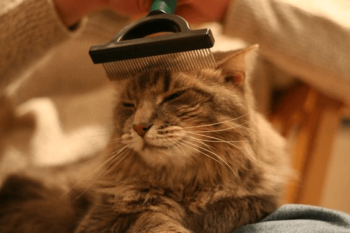A well-groomed long-haired cat is gorgeous, with their luxurious coat. To keep that coat in great shape requires a commitment to regular grooming. Long-haired cats often have layers of topcoat and undercoat, and these need to be kept free of mats and tangles to keep that coat gorgeous.
Practice Diligence In Your Grooming Commitment
Not staying on top of grooming can lead to a host of issues for your kitty. Mats and tangles develop all too quickly. These can cause discomfort or even skin infections. Not only that, but without regular brushing, your long-haired cat may ingest excess fur, increasing the risk of hairballs. These are no fun to deal with and can impact digestive health.
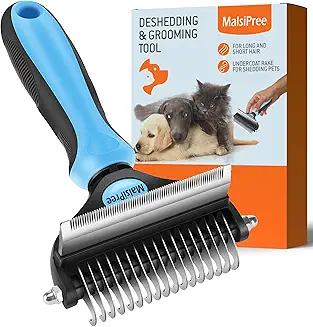
My Mocha has medium-long fur, but there’s enough of it that I’ve had to deal with the problems brought about by lots of fur. He develops mats in hard-to-access spots and I have to work diligently to minimize the problem. Usually, with a couple of sessions of gentle grooming, I can work out the mats. Today I had to call in the vet — Mocha had a largish mat on his tummy close to his hind legs. No way would he let me groom that spot! Time to enlist the expert. The vet brought a shaving tool with which she was able to remove the large mat. Meanwhile, I kept the front end of the cat busy by feeding him kibble, which he adores.
Regular Grooming Helps Reduce Hairballs
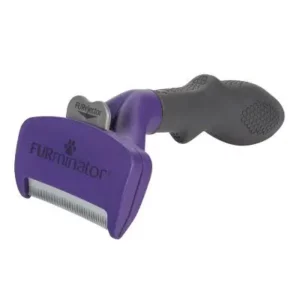
With a cat with lots of fur, hairballs can form all too easily. While grooming, the cat ingests far too much fur. With regular brushing, the amount of hairballs can be greatly reduced, as you help kitty to remove some of the excess fur he’s wearing. Regular care will help both you and kitty in the long run.
Understand The Shedding Schedule
That coat will be thicker in winter, and when the weather warms, kitty will start to shed more fur. This time becomes very important to you as you can help remove some of that excess, and your cat will ingest less of it.
If your cat has long fur, you can follow the recommendation of the experts, and give grooming attention several times a week, if not daily, depending on thickness and length of their coat, and the season of the year.
Create A Grooming Schedule
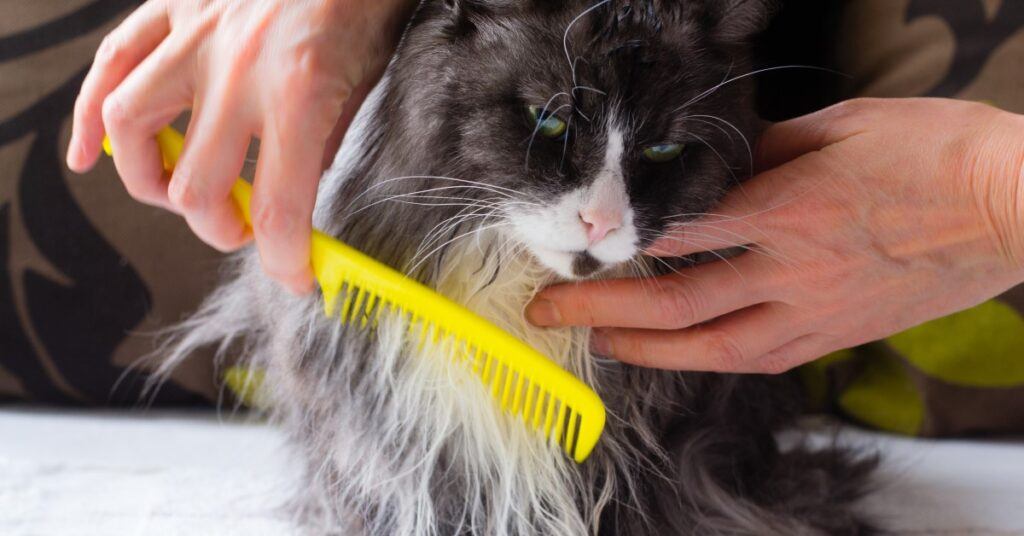
Cats do love their routines, and this practice applies even to grooming. If you brush daily, do so at the same time every day, so kitty comes to expect it. If grooming once or twice a week, choose days and times when kitty is calm and relaxed. Try to make the event stress-free. Talk softly and offer comfort. Groom in a location where the cat feels most comfortable. Make sure to include treats when you are finished.
Gather The Right Tools For The Job
I am including images of some of the possible tools you might need. Here are some tools you could have on hand:
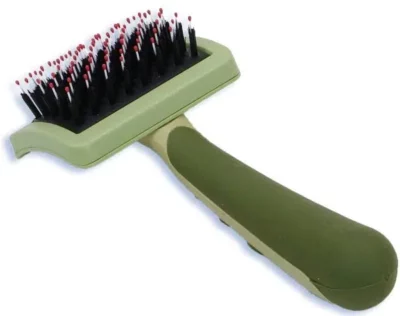
- Slicker brush (This one allows you to brush the cat and then push a button to push out the fur you have collected. Very handy!)
- Soft bristle brushes (Gentle on kitty’s skin)
- Combs with wide and narrow teeth
- Undercoat rake
- Mat splitter
- Grooming scissors (blunt-ended tool) or clippers
- Grooming gloves
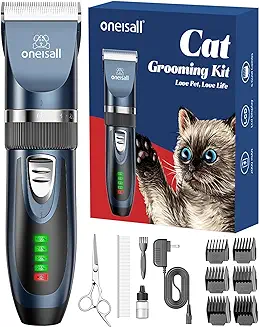
When it comes to scissors or clippers, I admit to cowardice. If something has to be cut out or shaved off the cat, I’d rather call in an expert. My vet knew just what to do, and as soon as we figured out how to get the cat to ignore what she was doing, by feeding him treats he loved, we had no problem. There’s no way I could have accomplished the task by myself.
The Right Tools Can Make The Job Much Easier
The right tools can make a world of difference when it comes to grooming a long-haired cat. A quality brush or comb, specifically designed for long fur, will detangle and remove loose hair without irritating your cat’s skin. Dedicated grooming gloves can also be an option, as they allow for a more tactile experience, which some cats may prefer.
So, How Do You Proceed?

When actually grooming your long-haired cat, always work in the direction of hair growth to avoid discomfort. Start with the slicker brush to gently work through any tangles. Follow this with the comb to further smooth the coat and remove finer loose hairs. If your cat has mats that you can’t brush out, use the scissors to carefully trim these away, taking care not to pull on the skin.
If you’re faced with stubborn tangles, a detangling spray formulated for cats can help. Apply it according to the instructions and gently work it into the mat with your fingers before attempting to brush it out again.
What About Bathing?

If you truly feel a bath will help, know that it can be tricky. If your cat has managed to play in the mud or has a dirty coat due to some activity he’s involved in, perhaps a bath becomes necessary. I once watched my cat chase an intruding cat in the back yard, through a swampy area that succeeded in covering him with mud. Though he emerged victorious in sending the interloper away, he had to have a bath. Into the tub he went, and though he didn’t fight the situation, perhaps realizing it was necessary. he sang his distress. His voice started on a low pitch and gradually raised in pitch and volume until the washing was finished.
If you must wash your kitty, make sure the water temperature is comfy — warm, but not hot — and use a shampoo designed for cats. Make sure to rinse his coat thoroughly.
Keep To Your Established Schedule
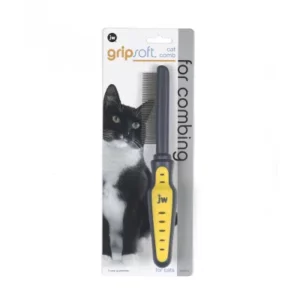
Consistency is vital. Regular grooming sessions not only keep your cat’s coat in good condition but also help to build a routine, making grooming something your cat can get used to and even enjoy. Aim for at least once a week, but you may find that during shedding seasons, more frequent grooming is necessary to keep on top of loose fur.
Remember, while some cats may initially be resistant to grooming, patience and positive reinforcement go a long way. Offer treats and praise to reward your cat for cooperating, as this helps to associate grooming with a positive experience.
Creating a Positive Grooming Experience for Your Cat
Grooming your long-haired cat doesn’t just stop with techniques and tools. The real success lies in making the entire process enjoyable for your feline friend. Employing positive reinforcement can turn a potentially stressful session into a bonding experience you both look forward to.
Hints For Achieving The Desired Goal
Begin by introducing grooming sessions when your cat is relaxed, perhaps after a meal or a play session. Use a soft voice and offer treats as rewards for cooperation. Combine grooming with gentle petting to make the event more appealing.
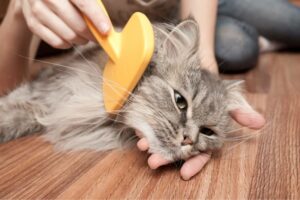
If your cat seems anxious or resists, never force the issue. Patience is key. Short, regular grooming sessions can help your cat get used to the routine without feeling overwhelmed.
Handling The Hard Core Situation
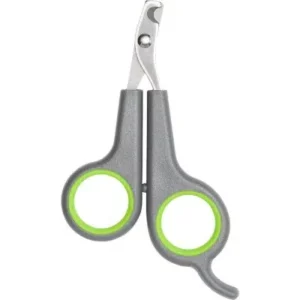
Mocha does not much care for grooming, so I keep my sessions short. Sometimes, even the most patient and gentle approach doesn’t work. He simply escapes. If you have a cat who simply won’t tolerate home grooming, you may have to seek the help of a professional groomer. In my situation, I’m in a small town that doesn’t have such an option. Thus, I groom Mocha for short periods that he will tolerate, hoping to build these up as he becomes more accepting of the process. If all else fails, I call the vet.

Remember, grooming is essential not only for your cat’s cleaning purposes but also for its health. Consistency, patience, and positivity can transform grooming sessions from a chore into moments of connection. I’m hoping that with time, Mocha might even start looking forward to the gentle brushes and the undivided attention received during these sessions, especially as he learns that he’ll be rewarded with treats. Patience, I believe, is the key.
References I used for this post:
https://www.catster.com/cat-health-care/how-to-groom-long-haired-cats https://cats.com/how-to-groom-a-long-haired-cat

